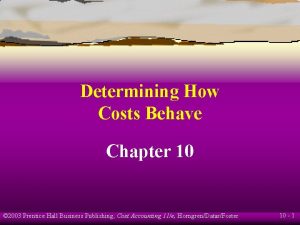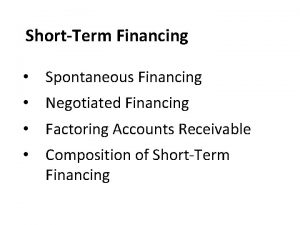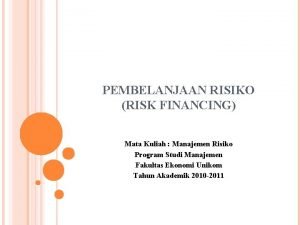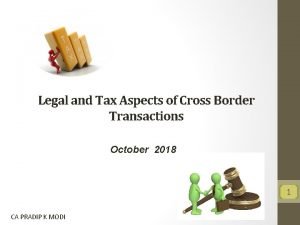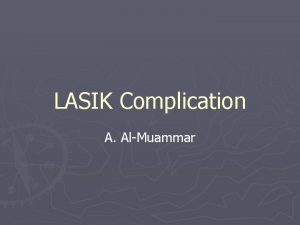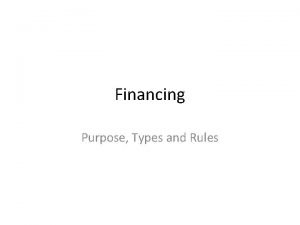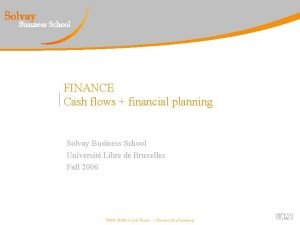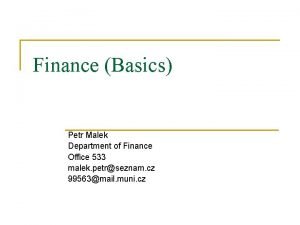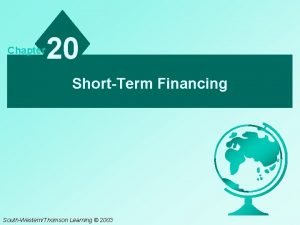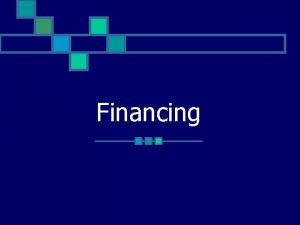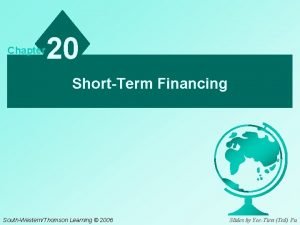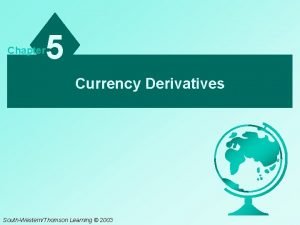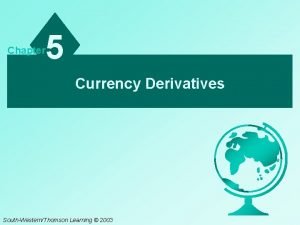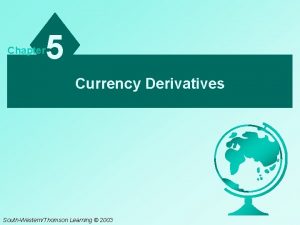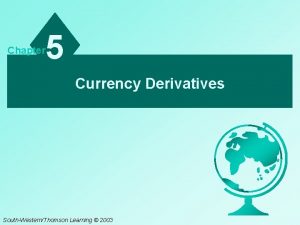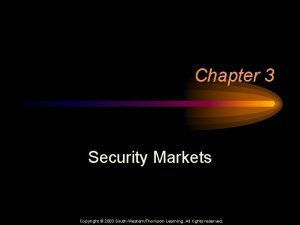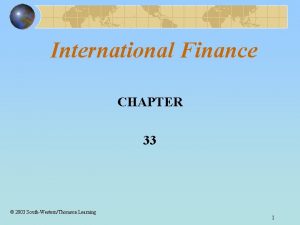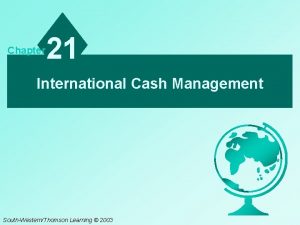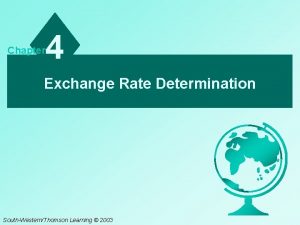18 Chapter LongTerm Financing SouthWesternThomson Learning 2003 Chapter























- Slides: 23

18 Chapter Long-Term Financing South-Western/Thomson Learning © 2003

Chapter Objectives • To explain why MNCs consider long-term financing in foreign currencies; • To explain how the feasibility of long-term financing in foreign currencies can be assessed; and • To explain how the assessment of longterm financing in foreign currencies can be adjusted for bonds with floating interest rates. C 18 - 2

The Long-Term Financing Decision • Because bonds denominated in foreign currencies sometimes require lower yields, MNCs often consider long-term financing in foreign currencies. • The actual cost of such financing depends on the quoted interest rate, as well as the changes in the value of the borrowed currency over the life of the loan. C 18 - 3

Annualized Bond Yields Across Countries Ten-year maturity, as of June 1998 Annualized Bond Yield Indonesian rupiah Malaysian ringgit Canadian Australian dollar ¥ Swiss franc US$ £ Thai baht C 18 - 4

Online Application • Long-term interest rates for major currencies for various maturities can be found at http: //www. bloomberg. com/, while currency forecasts are available at http: //biz. yahoo. com/ifc/. C 18 - 5

The Long-Term Financing Decision • To make the long-term financing decision, the MNC must determine the amount of funds needed, forecast the price (interest rate) at which the bond may be issued, and forecast the exchange rates of the borrowed currency for the times when it has to make payments (coupons and principal) to the bondholders. C 18 - 6

The Long-Term Financing Decision • Then the probability distribution of the bond’s financing costs may be determined. • An MNC that denominates bonds in a foreign currency may achieve major cost reductions, but is subject to the possibility of incurring high costs if the borrowed currency appreciates over time. C 18 - 7

Actual Costs of Financing With Pound-Denominated Bonds from a U. S. Perspective Exchange Rate of £ US$ Needed to Cover Annual Coupon Payment of £ 1 million C 18 - 8

Managing Exchange Rate Risk • Point-estimate exchange rate forecasts cannot adequately account for the potential impact of exchange rate fluctuations. • Instead, the probability distribution of the exchange rate should be developed, so as to determine the expected financing cost and its probability distribution. • Computer simulation may aid the process. C 18 - 9

Managing Exchange Rate Risk • The exchange rate risk from financing with bonds in foreign currencies can be reduced by using: offsetting cash inflows in the borrowed currency forward contracts currency swaps C 18 - 10

Illustration of A Currency Swap Euros Received From Ongoing Operations Euro Payments Miller Company [known within the dollardenominated market] Dollar Payments Investors in Dollardenominated Bonds Issued by Miller Dollars Received From Ongoing Operations Euro Payments Dollar Payments Beck Company [known within the eurodenominated market] Euro Payments Investors in Eurodenominated Bonds Issued by Beck C 18 - 11

Managing Exchange Rate Risk • The exchange rate risk from financing with bonds in foreign currencies can be reduced by using: parallel (or back-to-back) loans C 18 - 12

Illustration of A Parallel Loan U. S. Parent Subsidiary of U. S. - based MNC that is located in the U. K. Provision of loans Repayment of loans in the currency that was borrowed British Parent Subsidiary of U. K. - based MNC that is located in the U. S. C 18 - 13

Managing Exchange Rate Risk • The exchange rate risk from financing with bonds in foreign currencies can be reduced by using: parallel (or back-to-back) loans diversified portfolios of bonds that are denominated in several foreign currencies or currency cocktail bonds (which are bonds denominated in a multicurrency unit e. g. SDR) C 18 - 14

Floating-Rate Bonds • Eurobonds are often issued with a floating coupon rate. For example, the rate may be tied to the London Interbank Offer Rate (LIBOR). • If the coupon rate is floating, forecasts are required for both exchange rates and interest rates. C 18 - 15

Floating-Rate Bonds • When MNCs issue floating-rate bonds that expose them to interest rate risk, they may use interest rate swaps to hedge the risk. • Interest rate swaps enable a firm to exchange fixed rate payments for variable rate payments, and vice versa. They are used by bond issuers to reconfigure future bond payments to a more preferable structure. C 18 - 16

Illustration of An Interest Rate Swap Quality Company Choice of 9% fixed or LIBOR +. 5% Prefers variable Fixed Rate Payments at 9% Variable Rate Payments at LIBOR+. 5% Fixed Rate Payments at 9. 5% Risky Company Choice of 10. 5% fixed or LIBOR + 1% Prefers fixed Variable Rate Payments at LIBOR+1% Investors in Fixed Rate Bonds Issued by Quality Company Investors in Variable Rate Bonds Issued by Risky Company Gains ½ % Saves ½ % C 18 - 17

Floating-Rate Bonds • Note that financial intermediaries are usually involved in swap agreements. They match up participants and also assume the default risk involved for a fee. C 18 - 18

Use of Yield Curves to Make Debt Maturity Decisions • An MNC must decide on the maturity for any potential debt. To do this, the MNC may want to assess the yield curve in the country of the currency to be borrowed. • Since the slopes of the yield curves may vary across countries, the choice of shortterm, medium-term, or long-term debt financing may vary across countries too. C 18 - 19

Yield Curves Across Countries Japan Canada Italy Germany U. S. U. K. Annualized Yield (Japan only) Annualized Yield (except Japan) As of February 2001 Years to Maturity C 18 - 20

Impact of Long-Term Financing Decisions on an MNC’s Value Parent’s Long-Term Financing Decisions E (CFj, t ) = expected cash flows in currency j to be received by the U. S. parent at the end of period t E (ERj, t ) = expected exchange rate at which currency j can be converted to dollars at the end of period t k = weighted average cost of capital of the parent C 18 - 21

Chapter Review • The Long-Term Financing Decision Measuring the Cost of Financing ¤ Actual Effects of Exchange Rate Movements on Financing Costs ¤ • Managing Exchange Rate Risk Accounting for Exchange Rate Risk ¤ Reducing Exchange Rate Risk ¤ C 18 - 22

Chapter Review • Floating-Rate Bonds ¤ Hedging Interest Rate Risk • Use of Yield Curves to Make Debt Maturity Decisions • Impact of Long-Term Financing Decisions on an MNC’s Value C 18 - 23
 Kernel longterm
Kernel longterm Thomas silverstein
Thomas silverstein Cuadro comparativo e-learning m-learning b-learning
Cuadro comparativo e-learning m-learning b-learning Learning curves 2003
Learning curves 2003 Chapter 8 financing a business
Chapter 8 financing a business Scotiabank yield more financing
Scotiabank yield more financing Long term financing
Long term financing Warehouse finance
Warehouse finance Stages of venture capital financing ppt
Stages of venture capital financing ppt Philippe thiel
Philippe thiel Eca financing
Eca financing Spontaneous financing formula
Spontaneous financing formula Pembiayaan risiko (risk financing)
Pembiayaan risiko (risk financing) Basic entitlement is $36 000
Basic entitlement is $36 000 Club champion financing
Club champion financing Cross boarder transactions
Cross boarder transactions Flap lasik
Flap lasik Ibm client center
Ibm client center Robert fugard
Robert fugard Project financing codice appalti
Project financing codice appalti Financing purpose
Financing purpose Financing outflow
Financing outflow Direct financing
Direct financing Contract finance
Contract finance



